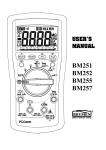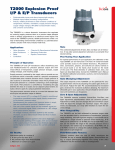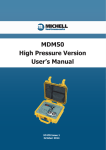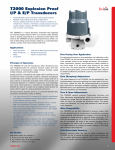Download what is clogging?
Transcript
CLOGGING IN JOULE THOMSON REFRIGERATORS? WHAT IS CLOGGING? Refrigerator clogging is caused by the formation of ice within the etched channels of the Joule-Thomson refrigerator. Ice forms because excessive moisture is allowed to enter into the refrigerator along with the high-pressure nitrogen gas. This moisture may be delivered with the gas (check to see if the gas purity level is correct, it should be 99.998%), or moisture may have collected in the high-pressure gas delivery system if that system was left open (unsealed) and exposed to the room environment. As the refrigerator cools down, this moisture strikes the cold walls of the etched channels and freezes to form ice. Ice builds up until it begins to obstruct gas flow through the channels of the refrigerator. As gas flow decreases, the cooling capacity of the refrigerator decreases. Eventually the cooling capacity of the refrigerator becomes equal to its heat load and cooling stops. If clogging is allowed to continue, the cooling capacity will be further diminished and the refrigerator will begin to warm up. HOW DO YOU DETECT CLOGGING? Clogging is indicated by a decrease in refrigerator gas flow rate during cool down or during steady state operation at low temperatures coincident with a decrease in refrigerator cooling capacity. By monitoring the refrigerator temperature and the refrigerator gas flow rate (read the flow rate with an accuracy of 0.1 scfh (standard cubic feet per hour) as a function of time (every 60 seconds) during a cool down, clogging can be quickly and easily diagnosed. WHY DOES CLOGGING OCCUR? Clogging occurs for one of two reasons. (1) Your filter could be saturated and is no longer functioning as a filter (this will normally happen after use of 3 or 4 tanks of gas OR when the inlet or the outlet of the filter has been left unsealed and, therefore, exposed to the contaminating moisture of the environment). So moisture and contaminants are passing right through the filter and into the refrigerator where they are freezing out and clogging channels with ice. (2) Your filter is good, but your refrigerator and gas lines have been contaminated with moisture and this moisture has not been sufficiently purged out of the sys- TSB-010 Revision C 1 TECHNICAL SUPPORT BULLETIN - CLOGGING tem. So enough moisture remains in the refrigerator or the high pressure gas lines to enter the refrigerator and to freeze out and clog channels. HOW DO YOU ELIMINATE CLOGGING? To eliminate clogging, the following procedure is recommended: NOTE Assume that the filter is saturated and change the filter contents using the refill kit materials supplied with the equipment when it was shipped to you. The filter refill kit consists of sealed packets of filter refill material which were shipped with the equipment. There is a remote possibility that these packets may have become contaminated by moisture if they have been stored in an area of high humidity for a long period of time (years). The user has to make a choice. Assume the filter refill kit is good and use the filter refill kit to recharge the filter, following the instructions in the equipment User’s Manual, and proceeding to step 2 below, or assume the filter refill kit has been contaminated and follow the instructions below starting with step 1. (1) Assume that the filter refill kit has been contaminated, even though it is still sealed. Open one package marked #1 and pour the contents on to a clean, dry glass dish. Open one package marked #2 and pour the contents on to another clean, dry glass dish. Make sure that you know which glass dish has material #1 in it and which dish has material #2 in it. Do not get the dishes mixed up. Put both dishes in an oven and set the temperature to 300 ºC (572 ºF). Leave the material in the oven overnight at 300 ºC. If you oven will not go to 300 ºC, go to the highest temperature available (Must be above 100 ºC) and use that temperature. Remove the filter from the high-pressure gas delivery system, making sure that you seal the end of each of the gas lines that had been connected to the filter. If you do not know how to do this contact Customer Service at MMR Technologies by phone [(650) 962-9620], fax [(650) 962-9647)] or e-mail ([email protected]). Prepare the filter to be refilled by following the instructions in the User’s Manual for the cooling system supplied by MMR Technologies. When the filter is ready to be refilled, turn off the oven and allow the filter materials to cool down until you can just handle the glass dishes (as hot as you can stand). Pour the hot filter material into the filter. Fill the filter according to the instructions, one component must be installed before the other. As soon as the filter is full, reinstall the fitting in the end of the filter and install the filter back into the system. Connect all gas lines. Do not disconnect them again. Revision C 2 TECHNICAL SUPPORT BULLETIN - CLOGGING (2) Make sure that your high-pressure gas supply tank is new and full (save any partially used tanks for later use). Disconnect the gas line to the refrigerator or chamber. Plug the nitrogen inlet on the refrigerator or vacuum chamber with the cap that was supplied with your equipment. Set the regulator valve for 50-100 psi. and let the nitrogen gas run through gas lines and filter for 10 minutes. Remove the inlet cap from the refrigerator or vacuum chamber and connect the gas line to the nitrogen inlet on the refrigerator or vacuum chamber. (3) Set the heater to 375K and purge the system with 500 psi nitrogen for 20 minutes, then adjust the gas pressure up to 1,800 psi and reset the heater to Zero K. Attempt to cool down the refrigerator in the vacuum chamber of the cooling system. Monitor time, vacuum pressure, flow rate and temperature as a function of time. It is suggested that you record a set of data every sixty seconds. (4) If you see clogging (as indicated by a decrease in gas flow rate coincident with a stop in cooling or the start of warming of the refrigerator), you now know that it must be because the gas lines and refrigerator are contaminated with moisture. You know this because you just refilled the filter and it has to be good. So if you see clogging now, turn off the gas using the valve at the tank. Do not touch anything else. Allow the system to warm up on its own (this will take 2 to 3 hours, but you want to be sure that the ENTIRE refrigerator has come to room temperature). Set the heater to 375K and purge the system with 500 psi nitrogen for 20 minutes, then adjust the gas pressure up to 1,800 psi. and reset the heater to Zero K Do not touch anything else! Do not disconnect and then reconnect gas lines. Do not bring the system up to atmospheric pressure and then pump back down. Do not open up the system vacuum chamber and then close and reseal it. Monitor time, vacuum pressure, flow rate and temperature every 60 seconds, as you have done before. (5) Now if you see clogging again during the second cool down, turn off the gas using the valve at the tank. Do not touch anything else. Allow the system to warm up on its own (this will take 2 to 3 hours, but you want to be sure that the ENTIRE refrigerator has come to room temperature). Revision C Set the heater to 375K and purge the system with 500 psi nitrogen for 20 minutes, then adjust the gas pressure up to 1,800 psi. and reset the heater to Zero K. Do not touch anything else! Do not disconnect and then reconnect gas lines. Do not bring the system up to atmospheric pressure and then pump back down. Do not open up the system vacuum chamber and then close and reseal it Monitor time, vacuum pressure, flow rate and temperature as you have before. 3 TECHNICAL SUPPORT BULLETIN - CLOGGING (6) Then if you see clogging again during the third cool down, turn off the gas using the valve at the tank. Do not touch anything else. Allow the system to warm up on its own (this will take 2 to 3 hours, but you want to be sure that the ENTIRE refrigerator has come to room temperature. Set the heater to 375K and purge the system with 500 psi nitrogen for 20 minutes, then adjust the gas pressure up to 1,800 psi. and reset the heater to Zero K. Do not touch anything else! Do not disconnect and then reconnect gas lines. Do not bring the system up to atmospheric pressure and then pump back down. Do not open up the system vacuum chamber and then close and reseal it. Monitor time, vacuum pressure, flow rate and temperature as you have before. It has been shown generally that even with the worst of clogging cases, one never has to go through this cycle more than six times. With each cooling, warm up, and purge cycle, the system should cool to lower and lower temperatures and the clogging will take place after a longer period of time. Finally the system gets purged clean and everything will function as it should. The key to maintaining proper system performance is to make sure that you never open up the high-pressure gas delivery system, so that it can be contaminated. If you must open it up (to change the gas tank or to change the filter or to disconnect the refrigerator or the vacuum chamber) then you must immediately seal everything. For example, if you disconnect the gas line from the refrigerator or vacuum chamber, then you must immediately put a cap on the high pressure gas inlet of the refrigerator to prevent moisture from migrating into the refrigerator and you must seal the end of the gas line (previously connected to the refrigerator high pressure gas inlet) to prevent moisture from migrating into the gas line. Leaving something open for even ten minutes is enough to start serious contamination of the system. Once the system is contaminated, you have to start all over again with the system purging process described above. So it pays to be meticulously careful to seal everything and to leave nothing open for any longer than necessary. HOW DOES ONE AVOID CLOGGING IN THE FUTURE? The key to getting a system clean (dry) is to start with a good filter, assemble the high pressure gas delivery system and then never touch it again, cycle the system as described above until you get no clogging, and then keep things clean forever after. Cleaning and reassembly of any part of the high pressure gas delivery system can only make things worse until you get the system clean (dry). Once you have things working the way they should, then you can worry about maintenance of the rest of the system, but everything you do should be done in such a way that you minimize any possible moisture contamination of the system. Revision C 4 TECHNICAL SUPPORT BULLETIN - CLOGGING FURTHER QUESTIONS If you have further questions, please do not hesitate to contact MMR Technologies, Inc.: Phone: +1 (650) 962-9620 Fax: +1 (650) 962-9647 E-mail: [email protected] Web: www.mmr-tech.com Revision C 5 TECHNICAL SUPPORT BULLETIN - CLOGGING Revision C 6














